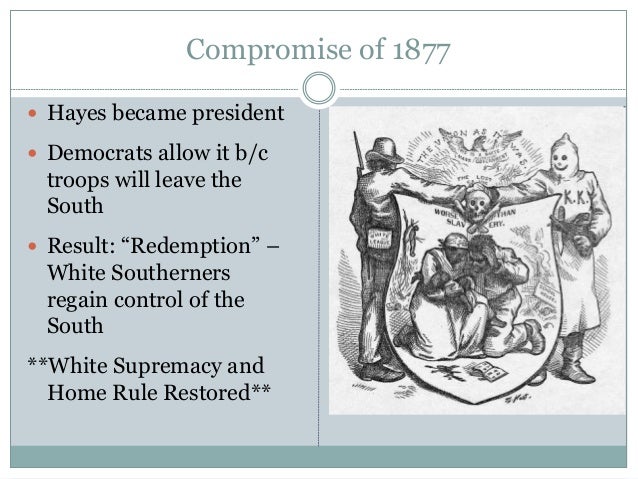On Election Day that November, the Democrats appeared to come out on top, winning the swing states of Connecticut, Indiana, New York and New Jersey. By midnight, Tilden had 184 of the 185 electoral votes he needed to win, and was leading the popular vote by 250,000. The Republicans refused to accept defeat, however, and accused Democratic supporters of intimidating and bribing African-American voters to prevent them from voting in three southern states–Florida, Louisiana and South Carolina. As of 1876, these were the only remaining states in the South with Republican governments.
In South Carolina, the election had been marred by bloodshed on both sides of the party line. Supporters of the Democratic gubernatorial candidate Wade Hampton, a former Confederate general, had used violence and intimidation to confront the African-American voting majority. A clash between black militia and armed whites in Hamburg in July ended in the death of five militia men after their surrender, while at Camboy (near Charleston) six white men were killed when armed blacks opened fire in a political meeting. With both sides accusing each other of electoral fraud, South Carolina, along with Florida and Louisiana, submitted two sets of election returns with different results. Meanwhile, in Oregon, the state’s Democratic governor replaced a Republican elector with a Democrat (alleging that the Republican had been ineligible), thus throwing Hayes’ victory in that state into question as well.

To resolve the dispute, Congress set up an electoral commission in January 1877, consisting of five U.S. representatives, five senators and five Supreme Court justices. The commission’s members included seven Democrats, seven Republicans and one independent, Justice David Davis. When Davis refused to serve, the moderate Republican Justice Joseph Bradley was chosen to replace him.
During the commission’s deliberations, Hayes’ Republican allies met in secret with moderate southern Democrats in hopes of convincing them not to block the official counting of votes through filibuster and effectively allow Hayes’ election. In February, at a meeting held in Washington’s Wormley Hotel, the Democrats agreed to accept a Hayes victory, and to respect the civil and political rights of African Americans, on the condition that Republicans withdraw all federal troops from South, thus consolidating Democratic control in the region. Hayes would also have to agree to name a leading southerner to his cabinet and to support federal aid for the Texas and Pacific Railroad, a planned transcontinental line via a southern route. On March 2, the congressional commission voted 8-7 along party lines to award all the disputed electoral votes to Hayes, giving him 185 votes to Tilden’s 184.
Hayes appointed Tennessee’s David Key as postmaster general, but never followed through on the promised land grant for the Texas and Pacific. Within two months, however, Hayes had ordered federal troops from their posts guarding Louisiana and South Carolina statehouses, allowing Democrats to seize control in both those states. As Florida’s Supreme Court had earlier declared a Democratic victory in the 1876 gubernatorial election, Democrats had been restored to power all across the South.

The Compromise of 1876 effectively ended the Reconstruction era. Southern Democrats’ promises to protect civil and political rights of blacks were not kept, and the end of federal interference in southern affairs led to widespread disenfranchisement of blacks voters. From the late 1870s onward, southern legislatures passed a series of laws requiring the separation of whites from “persons of color” on public transportation, in schools, parks, restaurants, theaters and other locations. Known as the “Jim Crow laws” (after a popular minstrel act developed in the antebellum years), these segregationist statutes governed life in the South through the middle of the next century, ending only after the hard-won successes of the civil rights movement in the 1960s.
